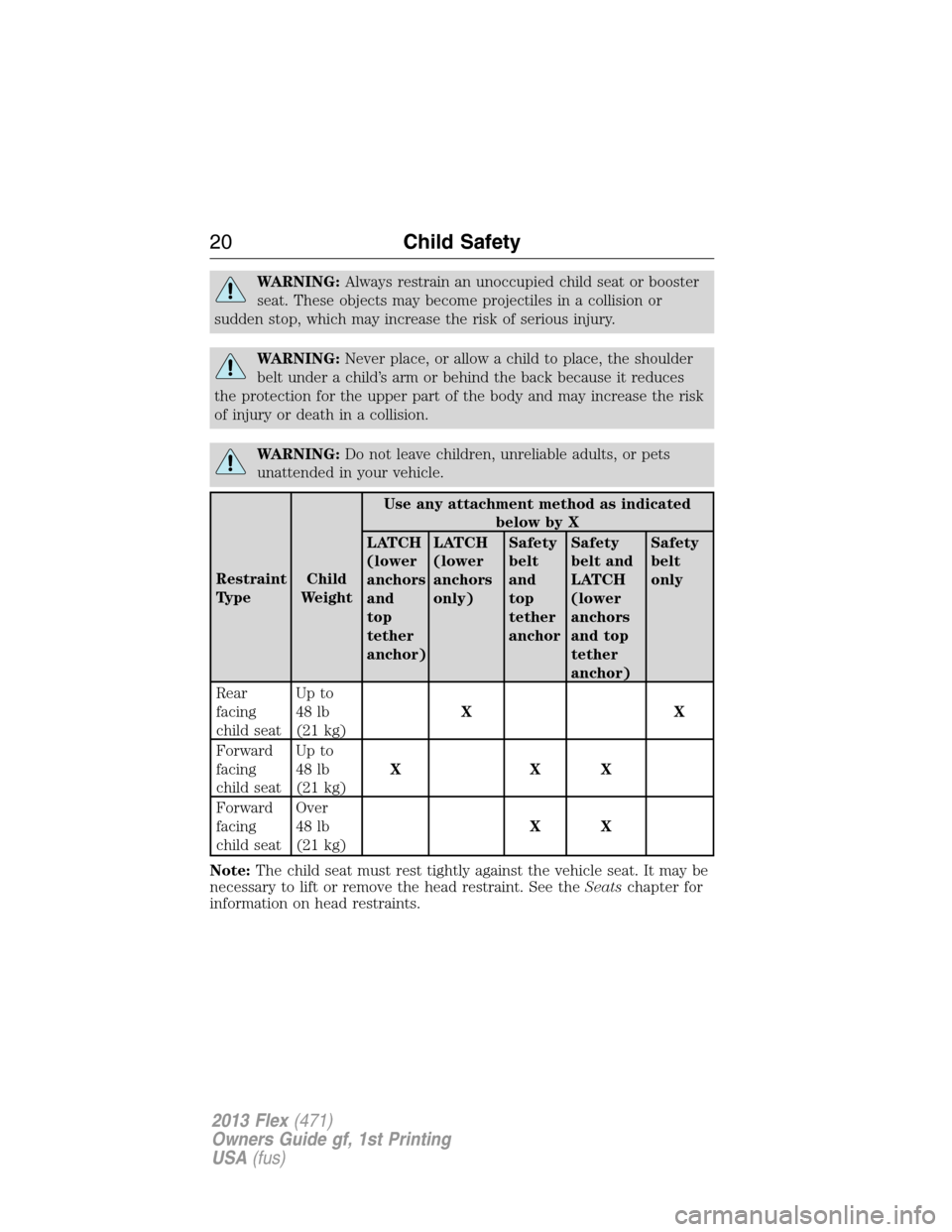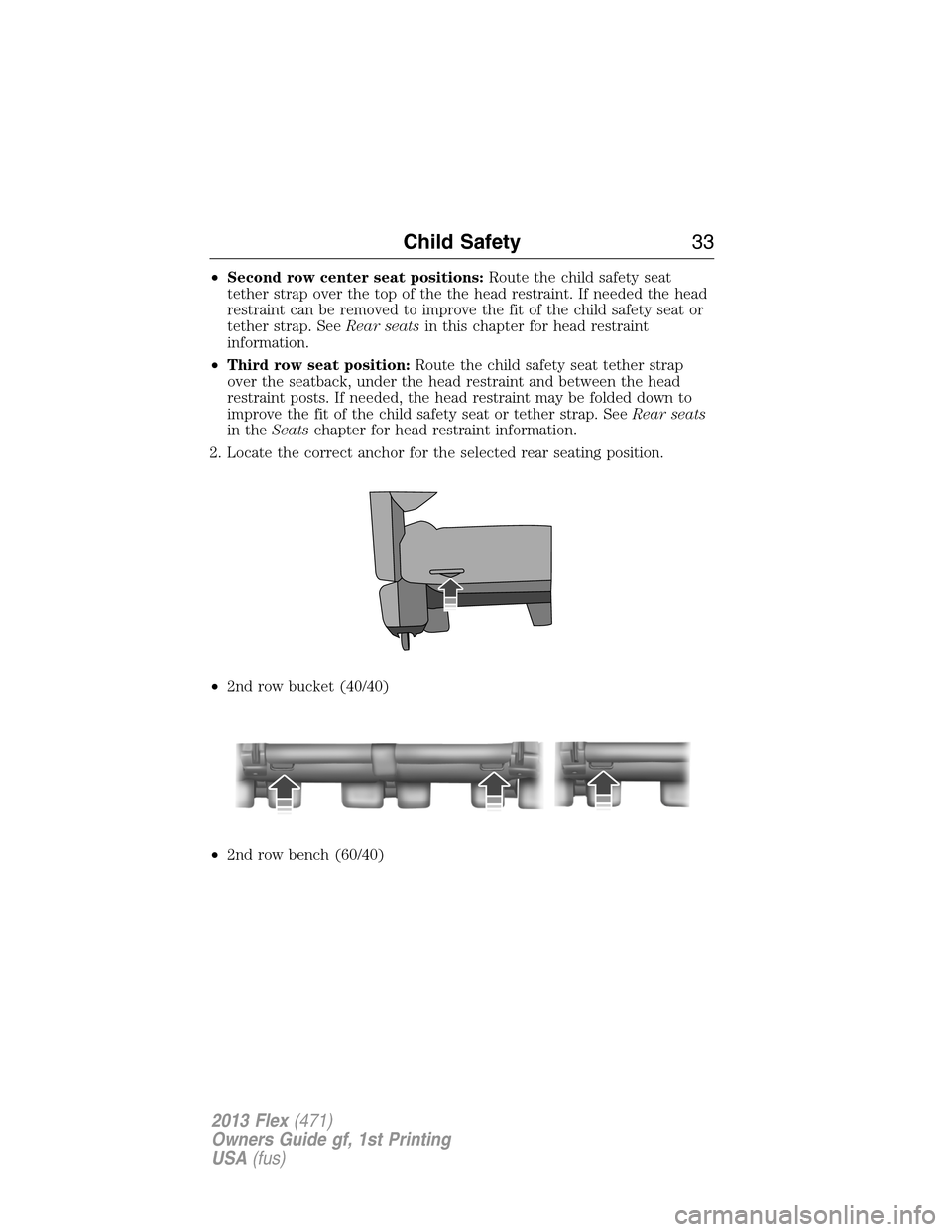2013 FORD FLEX remove seats
[x] Cancel search: remove seatsPage 20 of 558

WARNING:Always restrain an unoccupied child seat or booster
seat. These objects may become projectiles in a collision or
sudden stop, which may increase the risk of serious injury.
WARNING:Never place, or allow a child to place, the shoulder
belt under a child’s arm or behind the back because it reduces
the protection for the upper part of the body and may increase the risk
of injury or death in a collision.
WARNING:Do not leave children, unreliable adults, or pets
unattended in your vehicle.
Restraint
TypeChild
WeightUse any attachment method as indicated
below by X
LATCH
(lower
anchors
and
top
tether
anchor)LATCH
(lower
anchors
only)Safety
belt
and
top
tether
anchorSafety
belt and
LATCH
(lower
anchors
and top
tether
anchor)Safety
belt
only
Rear
facing
child seatUp to
48 lb
(21 kg)XX
Forward
facing
child seatUp to
48 lb
(21 kg)XXX
Forward
facing
child seatOver
48 lb
(21 kg)XX
Note:The child seat must rest tightly against the vehicle seat. It may be
necessary to lift or remove the head restraint. See theSeatschapter for
information on head restraints.
20Child Safety
2013 Flex(471)
Owners Guide gf, 1st Printing
USA(fus)
Page 22 of 558

Types of Booster Seats
•Backless booster seats
If your backless booster seat has a removable shield, remove the shield.
If a vehicle seating position has a low seat back or no head restraint, a
backless booster seat may place your child’s head (as measured at the
tops of the ears) above the top of the seat. In this case, move the
backless booster to another seating position with a higher seat back or
head restraint and lap/shoulder belts, or consider using a high back
booster seat.
•High back booster seats
If, with a backless booster seat, you cannot find a seating position that
adequately supports your child’s head, a high back booster seat would be
a better choice.
22Child Safety
2013 Flex(471)
Owners Guide gf, 1st Printing
USA(fus)
Page 24 of 558

INSTALLING CHILD SEATS WITH LAP AND SHOULDER BELTS
WARNING:Airbags can kill or injure a child in a child seat.
NEVERplace a rear-facing child seat in front of an active airbag.
If you must use a forward-facing child seat in the front seat, move the
seat all the way back.
WARNING:Children 12 and under should be properly restrained
in the rear seat whenever possible.
WARNING:Depending on where you secure a child restraint,
and depending on the child restraint design, you may block
access to certain safety belt buckle assemblies and/or LATCH lower
anchors, rendering those features potentially unusable. To avoid risk of
injury, occupants should only use seating positions where they are able
to be properly restrained.
When installing a child safety seat with combination lap/shoulder belts:
•Use the correct safety belt buckle for that seating position.
•Insert the belt tongue into the proper buckle until you hear a snap and
feel it latch. Make sure the tongue is securely fastened in the buckle.
•Keep the buckle release button pointing up and away from the safety
seat, with the tongue between the child seat and the release button, to
prevent accidental unbuckling.
•Place vehicle seat back in upright position.
•For second row seating positions, if needed, the recliner may be
adjusted slightly to improve child seat fit. If needed the head restraints
may be removed.
•For third row seating positions the head restraints may be stowed to
improve child seat fit, if needed. Refer toRear seatsin theSeats
chapter for information on folding the head restraints.
•Put the safety belt in the automatic locking mode. Refer to Step 5
below. This vehicle does not require the use of a locking clip.
24Child Safety
2013 Flex(471)
Owners Guide gf, 1st Printing
USA(fus)
Page 28 of 558

6. Allow the belt to retract to remove slack. The belt will click as it
retracts to indicate it is in the automatic locking mode.
7. Try to pull the belt out of the retractor to make sure the retractor is in
the automatic locking mode (you should not be able to pull more belt
out). If the retractor is not locked, repeat Steps 5 and 6.
8. Remove remaining slack from the belt. Force the seat down with extra
weight, e.g., by pressing down or kneeling on the child restraint while
pulling up on the shoulder belt (for standard safety belt) or pulling down
on the lap belt (for inflatable safety belt) in order to force slack from the
belt. This is necessary to remove the remaining slack that will exist once
the additional weight of the child is added to the child restraint. It also
helps to achieve the proper snugness of the child seat to the vehicle.
Sometimes, a slight lean towards the buckle will additionally help to
remove remaining slack from the belt.
•Standard safety belt
•Inflatable safety belt
9. Attach the tether strap (if the child seat is equipped). Refer to
Installing child safety seats with tether strapslater in this chapter.
28Child Safety
2013 Flex(471)
Owners Guide gf, 1st Printing
USA(fus)
Page 32 of 558

The tether strap anchors in your vehicle are in the following positions
(shown from top view):
•Second row bucket seats and
third-row passenger side
•Second row bench seats and
third-row passenger side
Perform the following steps to install a child safety seat with tether anchors:
Note:If you install a child seat with rigid LATCH attachments, do not
tighten the tether strap enough to lift the child seat off the vehicle seat
cushion when the child is seated in it. Keep the tether strap just snug
without lifting the front of the child seat. Keeping the child seat just
touching the vehicle seat gives the best protection in a severe crash.
1. Route the tether strap.
•Second row outboard seat positions:Route the child safety seat
tether strap over the seatback, under the head restraint and between
the head restraint posts. If needed the head restraint can be removed
to improve the fit of the child safety seat or tether strap.
32Child Safety
2013 Flex(471)
Owners Guide gf, 1st Printing
USA(fus)
Page 33 of 558

•Second row center seat positions:Route the child safety seat
tether strap over the top of the the head restraint. If needed the head
restraint can be removed to improve the fit of the child safety seat or
tether strap. SeeRear seatsin this chapter for head restraint
information.
•Third row seat position:Route the child safety seat tether strap
over the seatback, under the head restraint and between the head
restraint posts. If needed, the head restraint may be folded down to
improve the fit of the child safety seat or tether strap. SeeRear seats
in theSeatschapter for head restraint information.
2. Locate the correct anchor for the selected rear seating position.
•2nd row bucket (40/40)
•2nd row bench (60/40)
Child Safety33
2013 Flex(471)
Owners Guide gf, 1st Printing
USA(fus)
Page 55 of 558

Note:When the passenger airbag status indicator OFF lamp is
illuminated, the passenger side airbag (seat mounted) may be disabled to
avoid the risk of airbag deployment injuries.
After all occupants have adjusted their seats and put on safety belts, it’s
very important that they continue to sit properly. A properly seated
occupant sits upright, leaning against the seat back, and centered on the
seat cushion, with their feet comfortably extended on the floor. Sitting
improperly can increase the chance of injury in a crash event. For
example, if an occupant slouches, lies down, turns sideways, sits forward,
leans forward or sideways, or puts one or both feet up, the chance of
injury during a crash is greatly increased.
If you think that the state of the passenger airbag status indicator lamp is
incorrect, check for the following:
•Objects lodged underneath the seat
•Objects between the seat cushion and the center console (if equipped)
•Objects hanging off the seat back
•Objects stowed in the seatback map pocket (if equipped)
•Objects placed on the occupant’s lap
•Cargo interference with the seat
•Other passengers pushing or pulling on the seat
•Rear passenger feet and knees resting or pushing on the seat
The conditions listed above may cause the weight of a properly seated
occupant to be incorrectly interpreted by the front passenger sensing
system. The person in the front passenger seat may appear heavier or
lighter due to the conditions described in the previous list.
To know if the front passenger sensing system is operating
properly, refer toCrash sensors and Airbag Indicatorlater in
this chapter.
If the airbag readiness light is lit, do the following:
The driver and/or adult passengers should check for any objects that may
be lodged underneath the front passenger seat or cargo interfering with
the seat.
If objects are lodged and/or cargo is interfering with the seat; please take
the following steps to remove the obstruction:
•Pull the vehicle over.
•Turn the vehicle off.
Supplementary Restraints System55
2013 Flex(471)
Owners Guide gf, 1st Printing
USA(fus)
Page 56 of 558

•Driver and/or adult passengers should check for any objects lodged
underneath the front passenger seat or cargo interfering with the seat.
•Remove the obstruction(s) (if found).
•Restart the vehicle.
•Wait at least two minutes and verify that the airbag readiness light in
the instrument cluster is no longer illuminated.
•If the airbag readiness light in the instrument cluster remains
illuminated, this may or may/not be a problem due to the front
passenger sensing system.
DO NOT attempt to repair or service the system; take your vehicle
immediately to an authorized dealer.
If it is necessary to modify an advanced front airbag system to
accommodate a person with disabilities, contact the Ford Customer
Relationship Center at the phone number shown in theCustomer
Assistancesection of this owner’s manual.
SIDE AIRBAGS
WARNING:Do not place objects or mount equipment on or near
the airbag cover, on the side of the seatbacks (of the front seats),
or in front seat areas that may come into contact with a deploying
airbag. Failure to follow these instructions may increase the risk of
personal injury in the event of a collision.
WARNING:Do not use accessory seat covers. The use of
accessory seat covers may prevent the deployment of the side
airbags and increase the risk of injury in an accident.
WARNING:Do not lean your head on the door. The side airbag
could injure you as it deploys from the side of the seatback.
WARNING:Do not attempt to service, repair, or modify the
airbag, its fuses or the seat cover on a seat containing an airbag.
Contact your authorized dealer as soon as possible.
56Supplementary Restraints System
2013 Flex(471)
Owners Guide gf, 1st Printing
USA(fus)